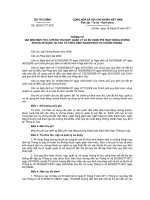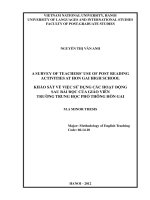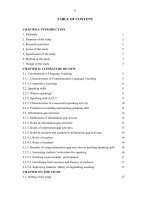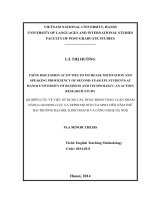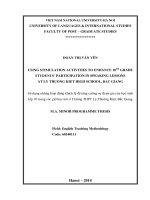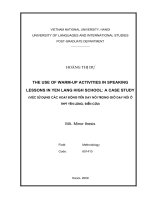Using supplementary activities to raise cross-cultural awareness of student in Hanoi University of Industry = Sử dụng các hoạt động bổ trợ nhằm nâng cao nhận th
Bạn đang xem bản rút gọn của tài liệu. Xem và tải ngay bản đầy đủ của tài liệu tại đây (918.84 KB, 65 trang )
Vietnam national university, hanoi
University of languages and international studies
Post graduate department
T NGC HIN MINH
Using Supplementary Activities to Raise Cross-Cultural
Awareness of Students in Hanoi University of Industry
Sử dụng các hoạt đông bổ trợ nhằm nâng cao nhận thức giao thoa văn hoá
của sinh viên Tr-ờng Đại học Công nghiệp Hà Nội
M.A Minor Thesis
Field: English Methodology
Code: 60 14 10
hà nội Năm 2009
Vietnam national university, hanoi
University of languages and international studies
Post graduate department
T NGC HIN MINH
Using Supplementary Activities to Raise Cross-Cultural
Awareness of Students in Hanoi University of Industry
Sử dụng các hoạt đông bổ trợ nhằm nâng cao nhận thức giao thoa văn hoá
của sinh viên Tr-ờng Đại học Công nghiệp Hà Nội
M.A Minor Thesis
Field: English Methodology
Code: 60 14 10
Supervisor: Dr. Trn Xuõn ip
hà nội Năm 2009
iv
TABLE OF CONTENTS
page
DECLARATION i
ACKNOWLEDGEMENTS ii
ABSTRACT iii
TABLE OF CONTENTS iv
ABBREVIATIONS vii
CHAPTER 1: INTRODUCTION 1
1.1 Rationale 1
1.2 Aims of the study 2
1.3 Scope of the study 2
1.4 Research questions 2
1.5 Methods of the study 2
1.6 Design of the study 3
CHAPTER 2: LITERATURE REVIEW 4
2.1 Culture and foreign language learning 4
2.1.1 Culture defined 4
2.1.2 Culture and language learning 5
2.1.3 Cultural awareness and cross-cultural awareness 5
2.1.3.1 Cultural awareness 6
2.1.3.2 Cross-cultural awareness 6
2.2 Culture teaching in conversational classes 6
2.2.1 What aspect of culture should be taught 6
2.2.2 Task based approach to incorporating culture into teaching 8
2.3 Activities for raising students’ cultural awareness in conversational classes9
2.3.1 Goals for incorporating culture into English speaking class 9
2.3.2 Activities for raising students’ cultural awareness in conversational classes 10
2.3.2.1 The summary of Christine Elmore’s activities 10
v
2.3.2.2 Elizabeth Peterson and Brownyn Coltrane’s activities 15
2.3.2.3 Deborah Peek’s activities 16
CHAPTER 3: SITUATION ANALYSIS 19
3.1 Situation analysis 19
3.1.1 Setting of the study 19
3.1.2 Participants and classroom context 19
3.2 Data collection instruments 20
3.2.1 Survey questionnaire 20
3.2.2 Tests 21
3.2.3 Class observation 21
3.2.4 Informal discussions 21
3.3 Data analysis 21
3.3.1 Survey questionnaire for teachers 21
3.3.1.1 An overview of culture teaching in HaUI 22
3.3.1.2 Teachers’ opinions of the difficulties in delivering cross – cultural elements in
speaking classes 23
3.3.1.3 Teachers’ opinions of the necessity of including cultural information in the lessons
23
3.3.1.4 Teachers’ opinions of the cross – cultural topics and activities for speaking lessons
24
3.3.1.5 Teachers’ difficulties in incorporating culture into speaking classes 25
vi
3.3.2 Activities applied for raising HaUI students’ cross-cultural awareness in speaking
lessons 25
3.3.3 Students’ test results before and after the study 27
3.3.4 Survey Questionnaire for the students before the study and after the study 29
3.3.4.1 Students’ participation in the speaking lessons with cross – cultural activities
29
3.3.4.2 Students’ self – evaluation of their cultural knowledge 30
3.3.4.3 Students’ opinion of the importance of culture for English learning 30
3.3.4.4 Students’ anticipation of the culture learning 31
3.3.4.5 Students’ opinions of speaking lessons with cross – cultural activities after the
study 32
3.3.4.6 Students’ difficulties in culture learning 34
3.4 Discussion of the findings 35
3.5 Implications for raising HaUI students’ cross – cultural awareness 37
3.5.1 Information sources 37
3.5.2 Activity types 37
3.5.3 Practical tips 37
CHAPTER 4: CONCLUSION 39
4.1 Summary of the study
4.2 Limitations of the study
4.3 Suggestions for further study
References 42
Appendices I
vii
ABBREVIATIONS
HaUI: Hanoi University of Industry
EFL: English as Foreign Language
ELT: English language Teaching
ELL: English Language Learning
1
CHAPTER 1: INTRODUCTION
1.1 Rationale
English learning does not only include grammatical competence and language proficiency, it
also includes culture learning. “Foreign language learning is comprised of several
components, including grammatical competence, communicative competence, language
proficiency as well as a change in attitudes towards one‟s own or another culture. For scholars
and laymen alike, cultural competence, i.e., the knowledge of the conventions, customs,
beliefs and systems of meaning of another country, is indisputably an integral part of foreign
language learning, and many teachers have seen it as their goal to incorporate the teaching of
culture into the foreign language curriculum.” (Dimitrios Thanasoulas,
)
From the idea above, it can be inferred that foreign language teaching can‟t be complete
without the transmission of cultural information in the lessons.
However, it is still controversial among many language teachers about the appropriate
teaching methods and cross – cultural activities used in speaking lessons in order that the
target of raising students‟ cross – cultural awareness can be met.
In HaUI, there has never been any study on raising students‟ cross – cultural awareness and
teachers‟ attitudes towards these issues. From my 8 years‟ experience as a teacher at HaUI, I
am aware that the teaching of culture has not been emphasized in this teaching context. The
curriculum in HaUI has not been designed to include culture teaching or developing additional
teaching and learning materials that includes English speaking countries‟ cultural values. In
speaking lessons, students are often asked to talk about the topic the teachers raise, taught
some expressions and new words. Cultural elements are rarely mentioned. Therefore, students
often ask me a lot of questions which are grammatically correct but culturally inappropriate.
2
These reasons have given rise to this study. It‟s the author‟s attempt to find out the effective
activities to raise students‟ cross – cultural awareness. It is hoped that this study will help the
situation in HaUI.
1.2 Aims of the study
The study is aimed at:
1. finding out the effective activities in raising students‟ cultural awareness
2. finding out the difficulties in incorporating cultural elements into speaking lessons at
HaUI
1.3. Scope of the study
The participants in the study are first year English majored students. They are in their 2
nd
semester. The textbook chosen for the course is Let’s talk 2. The study only focuses on
supplementary activities in raising students‟ cross – cultural awareness. Teaching „culture” in
this thesis refers to British and American culture in language use and in communication
contexts.
1.4 Research questions
The study is carried out to find the answers to the following research questions:
1. What are the effective activities for improving HaUI students‟ cross-cultural awareness?
2. What are the difficulties in incorporating cultural elements into speaking lessons at HaUI?
1.5 Methods of the study
In this study, action research is employed. The author makes comments, remarks, comparisons
and conclusions from observations, survey questionnaires, discussions and experience.
Survey questionnaires are utilized to survey the situation of teaching and learning culture at
the beginning of the study. They are also used to collect teachers‟ and students‟ opinions about
culture teaching and learning after the study. 2 tests are administered before and after the study
3
to figure out the differences in students‟ cultural knowledge. Observations and formal
discussions are also effectively combined in the study.
1.6 Design of the study
The study is divided into 4 chapters
Chapter I is an introduction to the research in which rationale, methods of the study
and research questions are discussed.
Chapter II reviews the literature of culture in foreign language teaching, the
relationship between culture and language learning. The study also looks at some influential
theories of activities used for teaching culture.
Chapter III discusses the context of the study, data collection methods and activities for
raising cross cultural awareness in HaUI. The author also analyzes the data collected to answer
the research questions. Changes in the results of the culture achievement tests are assessed
based on both quantitative and qualitative data collected through the test results, interviews,
informal discussions, observations and survey questionnaires.
Chapter IV includes the findings of the study and suggests further research.
4
CHAPTER 2: LITERATURE REVIEW
2.1 Culture and foreign language learning
2.1.1 Culture defined
Culture can be defined in many ways from many different perspectives. On a general level,
anthropologists define culture as “…the whole way of life of people or group. In this context,
culture includes all the social practices that bond a group of people together and distinguish
them from them” (Montgometry and Reid-Thomas, 1994:5).
In Nguyen Quang‟s view, “Culture is the whole complex of tangible and intangible
expressions that are created and adapted by a society or a social group as well as the ways it
functions and reacts in given situations; this helps distinguish one society or social group from
another not only in terms of the availability of those expressions and behaviors, but also in
terms of their proportionality and manifestability”. (Nguyen Quang, 2006:24)
According to Brown (1994: 170) culture is a deeply ingrained part of the very fiber of our
being, but language - the means for communication among members of a culture – is the most
visible and available expression of that culture. And so a person‟s worldview, self – identity,
and system of thinking, acting, feeling, and communicating can be disrupted by a change from
one culture to another.
From these points of view, it can be inferred that language and culture are inextricably linked.
Therefore, language teaching can not be separated from culture teaching.
2.1.2 Culture and language learning
Language and cultures are closely related in many ways. According to Claire Kramsch,
language is the principal means whereby we conduct our social lives (Claire Kramsch,
1998:3). When it is used in contexts of communication, it is bound up with culture in multiple
and complex ways.
5
To begin with, the words people utter relate to common experience. They express facts, ideas
or events that are communicable because they refer to a stock of knowledge about the world
that other people share. Words also reflect their authors‟ attitudes and belief, their point of
view that are also attitudes, belief and point of views of others. In both cases, language
expresses cultural reality.
But members of a community or social group do not only express experience; they also create
experience through language. According to Claire Kramsch (Claire Kramsch, 1998:3) “They
give meaning to it through the medium they choose to communicate with one another, for
example on the telephone or face – to – face, writing a letter or sending an e-mail message,
reading the newspaper or interpreting a graph or chart. The way in which people use the
spoken, written, or visual medium itself to create meanings that are understandable to the
group they belong to, for example, through a speaker‟s tone of voice, accent, conventional
style, gestures and facial expressions.” Through all its verbal and non-verbal aspects, language
embodies cultural reality.
According to Nguyen Van Do (Nguyen Van Do, 2006), language and culture can be seen as
the faces of paper. Language cannot exist “outside the social context; language is a social
institution; both shaping and shaped by society at large. This relationship can be illustrated in
the following trio relation diagram:
Language
Culture Society
2.1.3 Cultural awareness and cross – cultural awareness
2.1.3.1 Cultural awareness
Cultural awareness is a term we have used to describe sensitivity to the impact of culturally –
induced behavior on language use and communication (Barry Tomalin and Susan Templeski,
1993: 5).
6
As presented in the previous section, the forms and uses of a given language reflect the
cultural values of the society in which the language is spoken. Linguistic competence alone is
not enough for learners of a language to be competent in that language (Krasner, 1999).
Therefore, cultural awareness should be viewed as a significant component in communicative
competence. It is essential that language learners should be aware of the culturally appropriate
ways to express attitudes, address people, make requests, and express agreements or
disagreement .etc.
2.1.3.2 Cross – cultural awareness
There exist differences between cultures in the way people communicate, behave and act.
People use various terms to refer to communication between people from different nationality,
social or ethnic origin, gender, occupation and sexual preference.
„Cross – culture‟ refers to the meeting of two cultures or two languages across the political
boundaries of nation – states (Claire Kramsch, 1998:81). They are predicated on the
equivalence of one nation one culture language, and on the expectation that a “culture shock”
may take place upon crossing national boundaries.
Cross culture can be seen as culture in contact or culture encounters. Cross – cultural
communication does not only study cultural differences and their influences on the people‟s
behaviors but also see the similarities between them (crossing – common and different
aspects).
In foreign language teaching a cross – cultural approach is applied in order that students will
be aware of the cultural differences and equipped with knowledge and skills to act in puzzling
cross – cultural situations. This also assists them in achieving effective communication.
2.2 Culture teaching in conversational classes
2.2.1 What aspect of culture should be taught
7
As mentioned earlier, culture is defined differently from different aspects. Researchers,
therefore, have made many attempts to find out relevant cultural issues to delivers in foreign
language lessons.
Stephen More (1985) identifies the components of culture as: beliefs, values, norms, roles,
role conflicts and status, and those of language as morphemes, words and sentences.
Nelson Brooks (1983) identifies 5 meanings of culture: growth, refinement, fine arts, patterns
of living, and total way of life. He believes that pattern of living should receive the major
emphasis in the classroom. It is patterns of living that are the least understood, yet the most
important in the early phrases of language instruction. He labels this meaning of culture as
culture 4 and defines it as follows:
“Culture 4 (pattern of living) refers to the individual‟s role in the unending kaleidoscope of
life situations of every kind and rules and models for attitude and conduct in them. By
reference to these models, every human being, from infancy onward, justifies the world to
himself as best he can, associates with those around him, and relates to the social order to
which he is attached”
From the point of view of language instruction, culture and be divided into two types: deep
culture, or “culture with little c” (behavior culture) and “culture with big C” and big C
(achievement culture). Deep culture, or “culture with little c” focuses on the behavioral
patterns or lifestyles of the people: how they greet in the first meeting; which expression they
use to show sympathy, approval, etc. “Culture with big C” includes the humanistic
manifestations and contributions of a foreign culture: art, music, literature; architecture,
technology and politics.
Gail Robinson (1985), an American researcher in the area of cross – cultural education, reports
that when teachers are asked, “What culture means to you” the most common responses fall
into three interrelated categories: products, ideas, and behaviors. The broadening of „little c”
(behavior culture) can be expressed through the following diagrams
8
Elements of culture
In a nutshell, the type of culture we teach in conversational classes should be flexibly
comprised of both “big C” and little c”. “The study of culturally – influenced behaviors should
arise out of the language material being studied, but should nevertheless be clearly identified
and systematically treated as a regular feature of the language lessons.” (Tomalin and
Stempleski, 1993:7)
2.2.2 Task based approach in incorporate culture into teaching
Although intercultural communicative competence has long been viewed as an
important goal of EFL, many materials used to train learners or raise cross – cultural
awareness are limited in clarifying appropriate methods to carry out “culture part” in EFL
lessons. Incorporating culture into English speaking lessons entails more than teachers‟ merely
giving information and students‟ taking notes. According to Willis (1996) an appropriate
classroom task is “a goal – oriented activity in which learners use language to achieve a real
outcome”. In this way, tasks can actively engage learners or promote skills required for
negotiating meaning. Nunan similarly states that, a task “…is a piece of classroom work which
involves learners in comprehending, manipulating, producing, or interacting in the target
language while their attention is principally focused on meaning rather than form” (Nunan,
1989).
Behaviors
Customs
Habits
Dress
Foods
leisure
Ideas
Beliefs
Values
institutions
Products
Literature
Folklore
Art
Music
artefacts
9
2.3 Activities for raising students’ cultural awareness in conversational
classes
2.3.1 Goals for incorporating culture into English speaking class
According to Seelye (1994), to teach culture for understanding, the following goals should be
achieved:
Goal 1: Interest – The student demonstrates curiosity about the target culture and empathy
toward its people.
Goal 2: Who – The student recognizes the role expectations and other social variables such as
age, sex, social class, ethnicity and place of residence affect the way people speak and behave.
Goal 3: What – The student realizes that effective communication requires discovering the
culturally conditioned images that are evoked in the minds of people when they think, act, and
react to the world around them.
Goal 4: Where and when – The student recognizes situational variables and convention shape
behavior in important ways. (S/he needs to know how people in the target culture act in
common mundane and crisis situations).
Goal 5: Why – The student understands that people generally act the way they do because they
are using options society allows for satisfying basic physical and psychological needs, and that
cultural patterns are interrelated and tend mutually to support need satisfaction.
Goal 6: Exploration – The student can evaluate a generalization about the target culture in
terms of the amount of evidence substantiating it, and has the skills needed to locate and
organize information about the target culture from the library, the mass media, people, and
personal observation.
According to Tomalin and Stempleski (1993:7-8), Seelye (1993), Hammerly (1982, pp.522-
524), and Stern (1992, pp.212-215), the teaching of culture has the following goals:
10
To help students to develop an understanding of the fact that all people exhibit
culturally – conditioned behaviors
To help students to develop an understanding that social variables such as age, sex,
social class, and place of residence influence the ways in which people speak and
behave
To help students to become more aware of conventional behavior in common
situations in the target culture
To help students to increase their awareness of the cultural connotations of words and
phrases in the target language
To help students to develop the ability to evaluate and refine generalizations about the
target culture, in terms of supporting evidence
To help students to develop the necessary skills to locate and organize information
about the target culture.
To stimulate students‟ intellectual curiosity about the target culture, and to encourage
empathy towards its people
To help students develop an understanding of the dynamic nature of the target culture,
as well as their own culture.
2.3.2 Activities for raising students’ cultural awareness in conversational
classes
Teaching culture requires a lot of efforts from teachers in order that students can enrich their
cultural awareness with enthusiasm. In this paper, the author some practical activities
summarized by Christine Elmore, contributed by Elisabeth Peterson and Brownyn Coltrane
and Deborah Peck.
2.3.2.1 The summary of Christine Elmore’s activities
Christine Elmore (www.google.com) has summarized twelve ways of teaching culture as
follows:
11
* Cultural Islands
From the first day of class teachers should have prepared a cultural island in their classrooms.
Posters, pictures, maps, signs, and realia of many kinds are essential in helping students
develop a mental image. Assigning students foreign names from the first day can heighten
student interest. Short presentations on a topic of interest with appropriate pictures or slides
add to this mental image. Start students off by making them aware of the influence of various
foreign cultures in this country. Introduce students to the borrowed words in their native
language or the place-names of our country. This helps students to realize they already know
many words in the target language (i.e. poncho, fiesta, rodeo). A good introductory activity is
to send students on cultural scavenger hunts to supermarkets and department stores and have
them make lists of imported goods.
* Culture Capsules (developed by Taylor & Sorenson, 1961)
Culture capsules are generally prepared out of class by a student but presented during class
time in 5 or 10 minutes. A Culture capsule consists of a paragraph or so of explanation of one
minimal difference between the native culture and the target culture.Essentially a culture
capsule is a brief description of some aspect of the target language culture (e.g., what is
customarily eaten for meals and when those meals are eaten, marriage customs, etc.) followed
by, or incorporated with contrasting information from the students' native language culture.
The contrasting information can be provided by the teacher, but it is usually more effective to
have the students themselves point out the contrasts.
Culture capsules are usually done orally with the teacher giving a brief lecture on the chosen
cultural point and then leading a discussion about the differences between cultures.
* Culture Clusters
A culture cluster is simply a group of three or more illustrated culture capsules on related
themes/topics (about the target life) + one 30 minute classroom simulation/skit that integrates
the information contained in the capsules (the teacher acts as narrator to guide the students).
For example, a culture cluster about grades and their significance to university students could
12
contain the capsule about how a grade point average is figured plus another about what kind of
decisions (such as being accepted in graduate study, receiving scholarships, getting a better
job, etc.) are affected by a person's grade point average.
* Culture Assimilators
The culture assimilator provides the student with 75 to 100 episodes of target cultural
behavior. Culture assimilators consist of short (usually written) descriptions of an incident or
situation where interaction takes place between at least one person from the target culture and
persons from other cultures (usually the native culture of the students being taught). The
description is followed by four possible choices about the meaning of the behavior, action, or
words of the participants in the interaction with emphasis on the behavior, actions, or words of
the target language individual(s).
Students read the description in the assimilator and then choose which of the four options they
feel is the correct interpretation of the interaction. Once all students have made their individual
choices, the teacher leads a discussion about why particular options are correct or incorrect in
interpretation.
* Critical Incidents/Problem Solving
Critical incidents are another method for teaching culture. Critical incidents are descriptions of
incidents or situations which demand that a participant in the interaction make some kind of
decision. Most of the situations could happen to any individual; they do not require that there
be intercultural interaction as there is with culture assimilators. Generally, the procedure with
a critical incident is to have students read the incident independently and make individual
decisions about what they would do. Then the students are grouped into small groups to
discuss their decisions and why they made them they way they did. Then all the groups
discuss their decisions and the reasons behind them. Finally, students have to be given the
opportunity to see how their decision and reasoning compare and contrast with the decisions
and reasoning of native members of the target culture.
* Mini–Dramas
13
Mini–dramas consist of three to five brief episodes in which misunderstandings are portrayed,
in which there are examples of miscommunication. Additional information is made available
with each episode, but the precise cause of the misunderstanding does not become apparent
until the last scene. Each episode is followed by an open-ended question discussion led by the
teacher. The episodes are generally written to foster sympathy for the non–native of the
culture the "wrong" that is done to him or her by a member of the target culture. At the end of
the mini–drama, some "knowing" figure explains what is really happening and why the target
culture member was really not doing wrong.
With mini–dramas, scripts are handed out and people are assigned to act out the parts. After
each act, the teacher asks students (not necessarily the ones performing in the drama) what the
actions and words of the characters in the drama mean and leads them to make judgments
about the characters in the play. After all of the scenes have been portrayed and the "knowing"
figure has made his or her speech, students are asked to reinterpret what they have seen in
view of the information which the knowing figure provided.
* Audio–motor Units
Audio–motor units consist of verbal instructions for actions by students which the students
then carry out. They work very well for any cultural routine which requires physical actions
(e. g., eating with a knife and fork, shaking hands, listening actively, standing in line to buy a
ticket, etc.).
With an audio–motor unit, the classroom is set up as the required setting and with the required
props. Individual students are then directed orally by the teacher to carry out appropriate
actions. The process can be repeated several times with different students carrying out the
instructions. Once appropriate behavior is established, minor but relevant changes can be
made and students can see what factors require adjustment (e.g., Is it proper to shake hands
with adults and children in the same way? If two come in together and have to pass in front of
people, does it alter what anyone says or does?, etc.)
* Cultoons
14
Cultoons are like visual culture assimilators. Students are given a series of (usually) four
pictures depicting points of surprise or possible misunderstanding for persons coming into the
target culture. The situations are also described verbally by the teacher or by the students who
read the accompanying written descriptions. Students may be asked if they think the reactions
of the characters in the cultoons seem appropriate or not.
After the misunderstandings or surprises are clearly in mind, the students read explanations of
what was happening and why there was misunderstanding.
* Media/Visuals
Magazine pictures, slide presentations, and/or videos are among the kinds of media/visual
presentations which can be used to teach culture. Usually with this method, the teacher
presents a series of pictures or slides or a video with explanation of what is going on and what
it means in terms of the target culture. Many aspects of culture, such as appropriate dress for
activities, kinds of activities students participate in or the weekend, public transportation, etc.,
can be effectively presented with such visuals.
* Celebrating Festivals
Celebrating foreign festivals is a favorite activity of many students. Even though this activity
takes a lot of planning, it works well as a culminating activity.
* Kinesics and Body Language
Culture is a network of verbal and non-verbal communication. If our goal as foreign language
teachers is to teach communication, we must not neglect the most obvious form of non-verbal
communication which is gesture. At the beginning of the year, teachers can also show foreign
films to students just to have them focus on body movements.
* Cultural Consciousness-Raising
15
Attitude is another factor in language learning that leads to cross cultural understanding. The
organization of the notebook can be a useful tool in any discipline, but it can be of special
importance in the foreign language classroom as a cultural consciousness raising tool. From
the very first day of school the foreign language teacher should have students begin organizing
their notebook. The notebook should be divided into four sections: Vocabulary, Maps,
Grammar, Symbols. Each section of the notebook will have an illustrated title page.
2.3.2.2 Elizabeth Peterson and Brownyn Coltrane’s activities
Elizabeth Peterson and Brownyn Coltrane (2003) suggest seven activities for foreign language
classes as follows:
Authentic Materials
Using authentic sources from the native speech community helps to engage students in
authentic cultural experiences. Teachers can adapt their use of authentic materials to suit the
age and language proficiency level of the students. Students might describe the behaviors they
observe and discuss which of them are similar to their native culture and determine strategies
for effective communication in the target language.
Proverbs
Using proverbs is an interesting way to explore another culture since lifestyles; ways of
thinking of ordinary people in a society are often reflected in common proverbs.
Role play
Role plays give students chances to act out a miscommunication based on cultural differences.
For example, after having lessons about ways of accepting compliments, students could role
play in a situation in which an inappropriate way of receiving compliments is use. Other
students observe role play and try to identify the reason for the miscommunication.
Students as cultural resources
16
Exchange students, immigrant students can be invited to the classroom. These students
can share insights into the cultural life of native speakers of the language with language
learners.
Ethnographic studies
This is a very effective way for students to learn about the target language and culture.
Students can be sent to a community where they can carry out ethnographic interviews with
native speakers, record in note books, audiotapes or videotapes valuable observation.
Literature
Literary texts are often full of cultural information and evoke memorable reactions for readers.
Carefully selected texts for students to obtain specific goals might be very helpful to students‟
enlargement of cultural knowledge.
Film
Films and television programs are also good sources for students to improve cultural
knowledge. Through behaviors and manners of people in films and TV programs, students
learn a lot about culture of the target language.
2.3.2.3 Deborah Peek’s activities
Deborah Peek (1998) introduced some other activities, which can be used in the foreign
language class.
Quizzes
Quizzes are one of the most successful activity types. Quizzes can be used to test materials
that the teachers have previously taught, but they are also used in learning new information.
The teacher can ask the students to answer true or false to each of the questions in pairs or
groups. They will share their existing knowledge and common sense to give answers. It is not
important whether students get the right answer or not, but by predicting, students will become
17
more interested in finding out the right answer. The right answer can be given by the teacher,
through a reading, listening, or video. At this point, extra information can be provided.
Quizzes offer a high – interest activity that keeps students involved in learning.
Action logs
An action log is a notebook used for written reflection on the activities done during class
which also provides useful feedback for teachers. Students write it up after each class or at the
end of each class. By requiring students to evaluate each class activity for interest, usefulness,
difficulty and they must reconsider what they have learnt. Each students also records their
target for speaking English, what they think they actually achieve, the names of their
discussion partners, and their own comments on the activities.
Reformulation
When students have read an activity or listened to a story, the teacher may like to use
reformulation to check what they have learned and to reinforce it by retelling to a partner.
Reformulation simply means: “Explain what you just learned to your partner in your own
words‟. It is a very simple technique, but has proved very successful for leaning both culture
and language. Teachers can give readings for homework and requires student to take notes on
the content. These notes can be in the form of pictures, keywords, or mind – maps. In the next
class, teachers can ask students to reformulate the content of the reading with a partner using
their notes without looking at the original paper. Reformulation is also effective after watching
a short video extract or listening to a story. Through reformulation, students check what they
have learnt, find out things that they have missed from their partner, and improve their
language by noticing gaps in their own ability to explain.
Noticing
As students watch a video or are engaged with some other materials, you can ask them to
'notice' particular features. For example, they could watch a video of a target-culture wedding
18
and note all the differences with their own culture. Asking students to 'notice' gives a focus to
the materials by making it into a task, rather than simply passive viewing or listening.
Prediction
As mentioned above, prediction can be a useful tool in quizzes, but it can be equally useful in
using almost any materials. Like 'noticing', prediction can engage the students more actively.
For example, when you are telling a story, you can stop at a certain point and ask the students
to predict how it will continue. Or, when you are giving out a reading for homework, first give
the title of the reading and ask students to predict what they will learn. This will force them to
review their existing knowledge of the topic and raise their curiosity about whether their
prediction is correct or not.
Research
Student research is one of the most powerful tools that we can use with college students
because it combines their interests with the classroom. For example, after the first class, we
ask students to search the internet or library and find information on any aspect of the target-
culture that interests them. In the following class, students explain to their group what they
have learned and answer any questions about it. This can lead to poster-sessions or longer
projects. For some students, it can even lead to a long-term interest in the target-culture.
Activities are varied for raising students‟ cross – cultural awareness. However, some certain
activities are better selected in certain classroom contexts with different students at different
English level. Under any circumstances, it is undeniable that students can only be successful in
language learning if cultural issues are an indispensable part in foreign language teaching
curriculum.
19
CHAPTER 3: SITUATION ANALYSIS
In this chapter, the author describes the situation where the study is conducted and the
participants involved. Different methods of data collection are also discussed in detail.
Activities applied in the study are described. Besides, the author focuses on the analysis of the
data collected from survey questionnaires and tests to find out the truth about the effective
activities for raising HaUI students‟ cross-cultural awareness and difficulties in including
cultural issues in speaking lessons.
3.1 Situation analysis
3.1.1 Setting of the study
The study is carried out at HaUI. This study targets at English major students who are trained
to become interpreters and translators. Like interpreter and translator trainees from other
universities, students at HaUI are required to take English courses as major subjects for 4
years. Textbooks such as Let’s talk 2, Speak up, Listen to it, Academic Writing, etc are
chosen to develop four basic skills. In the first semester, Let’s talk 2 is selected as a
mainstream textbook to improve students‟ speaking skill. It is believed that this book will help
students to know how to speak in English in some common conversational situations.
However, it seems that the textbook tends to focus on expressions and at HaUI little attempts
have been made to draw students‟ attention to cross – cultural issues.
3.1.2 Participants and classroom context
The study is carried out with the participation of 180 students (from English classes 1A,1B,
1C, 2A, 2B) and 40 teachers at HaUI in 15 weeks.
All the 40 teachers participating in the study graduated from University of Languages and
International Studies, Vietnam National University, Hanoi. They have been teaching English
for at least 3 years.

